Marketing for Brokers and Consultants – Ideas for Promo Videos
Many of our clients hesitate to use video because they don’t have a tangible product. Or, they just don’t want to appear on camera. Or, they don’t have the budget to hire a professional video crew or studio editing.
Here are three ideas for aircraft brokers and consultants to demonstrate the value of their services.
[smart_track_player url=”http://traffic.libsyn.com/aviationmarketing/Aviation_Marketing_Video_Promos_for_Consultants.mp3″ background=”default” ]
Transcript – Marketing for Brokers and Consultants – Ideas for Promo Videos
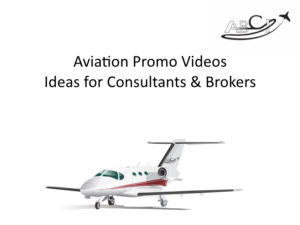 Paula Williams: Welcome to this week’s episode of our Aviation Marketing podcast, which is actually the bestselling Aviation Marketing podcast on the planet.
Paula Williams: Welcome to this week’s episode of our Aviation Marketing podcast, which is actually the bestselling Aviation Marketing podcast on the planet.
John Williams: Really?
Paula Williams: Well it’s the only aviation marketing podcast on the planet. But still.
John Williams: I guess then that’s true!
Paula Williams: Exactly. So this week we’re talking about aviation promo videos. Last week we talked about promo videos in general for aviation, and everybody that we’ve been talking to making plans for 2020 is planning more video.
Everybody Knows Video is Effective, But Aviation Brokers and Consultants Ask How They Can Use it In their Practice.
And everybody’s asking, “Okay, well that was great and we’ve got some examples, but can you give us some more examples about my little corner of aviation?” So we decided to do a series, this one is going to be for consultants and brokers and then we are also going to be talking in the future about MROs and FBOS and other folks, charters and so on. And if there’s anything in particular you’d love to hear, let us know, because we would love to talk about it.
John Williams: So, you’re telling me they’re all different.
Paula Williams: Oh yeah.
John Williams: Really?
Paula Williams: Some of them are the same, but there are some ideas that are slightly different for each vertical, depending on what your job is in aviation and who you’re…
John Williams: And what to do or how to go about it.
Paula Williams: List, offer, and presentation, or there might be different ways to make it happen.
John Williams: We’re talking about a video.
Paula Williams: Yeah.
John Williams: So what, or how is different?
Paula Williams: Yes. I’ll explain.
John Williams: Well I hope so.
This Episode Brought to You By Our Aviation Content Marketing Service
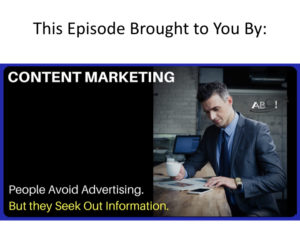 Paula Williams: Okay. All right. So this episode, as this entire series, is brought to you by our content marketing subscription product, which in the past has always been about print, articles and other things, press releases and so on. But it’s meant to be a flexible product, so that an aviation company might, some months they want a press release, some months they want to do a video, some months they want to do something else.
Paula Williams: Okay. All right. So this episode, as this entire series, is brought to you by our content marketing subscription product, which in the past has always been about print, articles and other things, press releases and so on. But it’s meant to be a flexible product, so that an aviation company might, some months they want a press release, some months they want to do a video, some months they want to do something else.
So small to medium-sized companies in the aviation industry, which most of them are that aren’t Boeing or whatever, have flexible needs or seasonal needs and other kinds of things where they need different marketing services, different months. So video is one of the options that you can use in this subscription. And some people, especially aircraft brokers, are doing pretty much all video with a subscription nowadays.
John Williams: True.
You Don’t Need A Full Video Crew and Studio for Every Kind of Video Marketing.
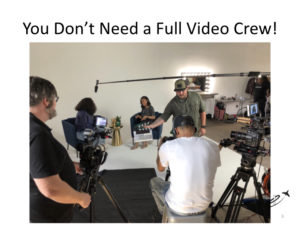 Paula Williams: All right. Okay. So last week we talked about the fact that you don’t need a full video crew, right?
Paula Williams: All right. Okay. So last week we talked about the fact that you don’t need a full video crew, right?
John Williams: Like this.
Paula Williams: Right. You don’t need the hairstylists, you don’t need, well, this is not necessarily true.
Sometimes you’re going to want a full crew and all the resources of a video studio.
I mean let’s say somebody gave you a Super Bowl spot, or gave you 15 minutes in a room with your most qualified decision makers, and promised-
John Williams: You mean, like the president of Gulfstream.
Paula Williams: Exactly. And promised that they would all be sitting there attentively while you did whatever you wanted with them for 15 minutes. If you had that opportunity, then it’s probably worth getting the full video crew and doing all of that. Having the fuzzy microphones and the light sets and the booms and the gaffers and the whatever they are, you know, grips.
Movie Math – Sometimes “Real Life Quality” Is Good Enough to Be Effective.
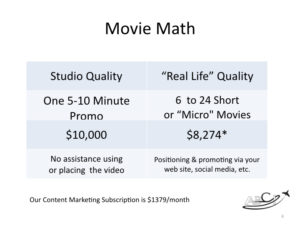 But I wanted to show you a little bit of movie math.
But I wanted to show you a little bit of movie math.
John Williams: Oh yes. Therein lies the rub.
Paula Williams: Okay. So for studio quality video, one five or 10 minute promo video with the hairstylists and the grips and the gaffers and the lighting-
John Williams: And the post processing.
Paula Williams: Right. And everything else is going to run you at least $10,000. That’s kind of a basement amount for a full crew video shoot.
John Williams: You mean a baseline amount.
Paula Williams: Yeah. Right. And then you get no assistance in terms of what to do with the video once it’s produced, in terms of deploying this in the most effective way.
John Williams: No, they just hand it over to you on a little chip or whatever.
Paula Williams: They give you a nice little CD or a broadcast or whatever they need to do to-
John Williams: And say thank you very much. And our friend the aircraft broker is left to figure out how to use it for himself.
Video Producers are Usually Specialized in Producing Great Art. They Aren’t Experts in Selling Aviation Services.
Paula Williams: Exactly. And they shake your hand and they go on their way. And that, like we said, if you happen to have an opportunity that requires a super polished, glossy high quality video for Marketing for Brokersthen by all means this can be absolutely worth it. But for most of us, most of the time, if you’re going to be spending about that amount of money, you would be better off getting six to 24 short, or micro movies, and we’re going to explain what we mean by short or micro movies as we go through this. And they’re going to be what we call real life quality. So as an example, you’d be taking the video on your location. What?
John Williams: What, me?
Paula Williams: No. You meaning Mr. Customer, who’s listening to this podcast. Okay. If I say, “John will be taking your video”, and he sometimes does that when we do road trips, and we visit customers, sometimes we’ll take some video on the fly, just impromptu, whatever we can get kind of video. If we were doing the studio quality type of a situation, we would be sending an entire crew, and we can do that.
John Williams: But when we do it on the road, we will rent the quality camera, and we have the recording equipment for audio, and then we will set it all up and do it.
Paula Williams: And we’ll get somebody like Taylor Greenwood or somebody like that to do the studio quality set up, and everything else that’s really familiar with how to light the exterior of a plane, and don’t try this at home kids, that kind of thing.
Even High End Buyers are Often More Interested in Transparency than Polish.
Okay. But real life quality, this is kind of an example. We’re using just our regular office with kind of regular office lighting, nothing glamorous. This is just kind of what we look like.
John Williams: But even so, there’s quite a few dollars worth of equipment to make this happen.
Paula Williams: Exactly.
John Williams: But nowhere near what it takes for studio or broadcast quality.
Paula Williams: Exactly. And you know, for a lot of these videos you don’t even need to appear on camera. So if you are camera shy or your boss is camera shy, don’t turn this off now, there are ways that make this work with stock footage and photographs and animation, slides, other kinds of things that will be just as effective as live video without the cost.
But then we also do a lot of work in terms of positioning and promoting your video to the list. We do a lot of the work from the marketing perspective, so in some cases people hire a video agency, and they’re really kind of an artistic video agency. They’re not a marketing video agency, so they’re not as concerned about making sure that you’ve got a call to action at the end, making sure that it’s going to work for your marketing purposes, making sure you’re hitting the right list, the right offer, and the right presentation to make sales. So we’re a marketing company that does video as opposed to a video company that does marketing.
John Williams: That doesn’t do marketing.
Paula Williams: Exactly. Okay. So those are some options in terms of movie math, we can do either one and we can help you set up either one. But today we’re kind of talking about the latter. The real life quality, six to 24 micro movies that you might want to plan over the course of 2020, using our content marketing situation.
The Rest of this Discussion is about “Real Life” Quality Video
John Williams: We do have the resources to set up broadcast quality, just ask.
Paula Williams: Yeah, absolutely. So that is something that we can do. All right, so one of the things that aviation consultants and brokers and folks like that talk about with us is, I sell a service, so I don’t always have a product that I can demonstrate on camera. Sometimes as an aviation broker, I may be selling an airplane and I don’t have access to that airplane. There are other things that come into play that make me feel like I can’t do video. Not true, right?
John Williams: True. I mean, yes, that’s not true.
Paula Williams: Yes, I am right that that’s not true.
John Williams: Yeah, exactly.
Every Bit of Marketing Content, Even Video, Should Follow the Rules of Marketing Campaigns.
 Paula Williams: Thank you. Of course I’m right. So, all right, so there are three elements of any marketing campaign, and we’ve talked about this numerous times, but a list, an offer and a presentation. So the three things you want to be looking at as a consultant are these :
Paula Williams: Thank you. Of course I’m right. So, all right, so there are three elements of any marketing campaign, and we’ve talked about this numerous times, but a list, an offer and a presentation. So the three things you want to be looking at as a consultant are these :
First, the list.
Who am I talking to?
What are their concerns? You want to put yourself in the shoes of the prospective clients on your list, and think about, what did they want to see that’s going to best position this?
Second, the offer.
What is my offer? What is it that am trying to sell right now, and why is it better than any of my competitors, and how can I demonstrate or illustrate that fact using video?
Third, the presentation.
And the third thing is the presentation. And that’s what the rest of this is about.
John Williams: Don’t knock the microphone now.
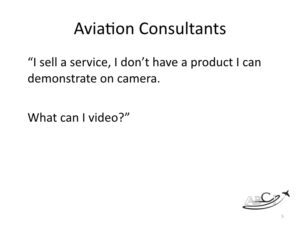 Paula Williams: Is not knocking the microphone, that would be one example of how to improve your presentation, is all of the technical aspects of how to make this work better. Now, when you hire most video companies, they’re going to spend all the time on the presentation. They’re not going to talk to you about the list or the offer all that much. They’re just going to assume you have that all figured out.
Paula Williams: Is not knocking the microphone, that would be one example of how to improve your presentation, is all of the technical aspects of how to make this work better. Now, when you hire most video companies, they’re going to spend all the time on the presentation. They’re not going to talk to you about the list or the offer all that much. They’re just going to assume you have that all figured out.
John Williams: Absolutely. It’s what they do.
Paula Williams: That is what they do. As a marketing company, we care just as deeply, or maybe even more deeply about your list and your offer than we do about your presentation.
John Williams: Right. Because without those, this is a waste of money.
Paula Williams: Waste of time and energy and frustration and headaches and money. So I think we’re probably living proof that your presentation doesn’t have to be perfect in order to be effective. So if our list and our offer is good, our presentation can be real life, and very transparent of who we are, without being over the top glossy and perfect. Okay. So those are the three elements of a campaign. There’s three elements of a great video, story, branding, and a call to action. Why do we care about these things?
John Williams: I suppose you’re going to tell me.
Great marketing video tells a story, has clear branding, and has some call to action.
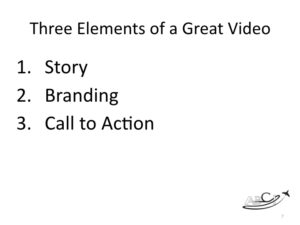 Paula Williams: There’s a lot of bad video out there. It used to be a year ago that video was so novel that any video would outperform any still photo or any still article, text article, those kinds of things simply because it was a video.
Paula Williams: There’s a lot of bad video out there. It used to be a year ago that video was so novel that any video would outperform any still photo or any still article, text article, those kinds of things simply because it was a video.
Now brokers are not competing against still photos and articles.
We’re competing against videos that our competitors are making.
Think like a storyteller.
So story becomes much more important, and even if it is a one minute video, there’s kind of an arc of story that needs to happen. You ask a question, then it doesn’t get answered till the end of the video. Something like that. That’s more satisfying by watching the full video. And we do have a podcast on how to tell a story with a beginning, a middle, and an end.
Use good, recognizable, consistent branding that is in harmony with the rest of your marketing.
Paula Williams: So if you don’t know what I’m talking about, that’s a really good explanation for that. Second thing is branding. So if you’re doing marketing for brokers, you’re not Budweiser, we can’t just show Clydesdales and puppies and have it sell our product. In most cases we’re not that famous yet. So we’re going to have to do some more work to make sure that what we’re doing is branded to our company, so when people see a great video or a great explanation for something, they know who it came from and how to get in touch with us. So branding’s important.
Call to action -what do you want the viewer to do next?
And the third thing is call to action. What do you want them to do when this video finishes?
John Williams: And branding is not just for the smaller companies. If you were at NBAA and saw how Gulfstream presented their new airplane, the G700, then you can see branding all the way through that.
Paula Williams: From the shape of the airplane, to the arc of the camera. Everything was very, very Gulfstream. They have a specific way of doing things, and are very good at the discipline of maintaining that. You probably don’t need that level of discipline for the types of videos that we’re talking about. But the more elements of branding that you can do, the better. Which is not to say take it over the top and have your logo this big on every slide. But you do want to make sure that people will remember who you are at the end of the video. That’s really the purpose of that.
Every video needs a call to action. What do you want people to do after seeing the video?
Third thing, call to action. What do you want to do at the end of the video? Obviously you want them to buy your product, but there’s probably something more specific than that. You want them to click a link, click a button, call a number, visit a website, fill out a form. There’s something that you want them to do as a result of having watched this video.
John Williams: You’ve got to have that in there, or they won’t do it.
Be a newscaster or “talking head.”
Paula Williams: Right. Exactly. Okay, so I’m going to talk about a couple of things that you can do as a consultant that work really, really well. One is speaking on camera. Let people see your face. If you are willing and able to do this, this is very effective because people feel like they know you, they feel like they’ve talked with you, they know how you speak, they know how you feel about certain things, and so on.
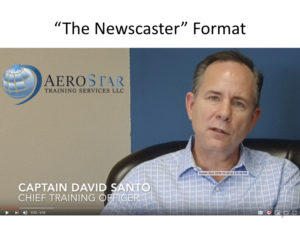 And this is Captain David Santo of Aerostar Training Services, being a newscaster in some videos that we created for them. And you can see one of the nice things about this is that they left some space in here for us to do some images behind his head there.
And this is Captain David Santo of Aerostar Training Services, being a newscaster in some videos that we created for them. And you can see one of the nice things about this is that they left some space in here for us to do some images behind his head there.
Here it’s his branding.
But this actually changes in the course of this video in a series of videos that we’ve done for them showing the simulators, and showing the flight line, and showing the classrooms and other kinds of things so that whatever he’s talking about, we’re illustrating just like a newscaster often has that little picture behind them.
And then also the captions across the bottom.
Green screen not required.
John Williams: And you don’t need a green screen to make this happen.
Paula Williams: No you don’t. This is a wall. And once again, this is just real life.
And the interesting thing about this is this can actually be more credible than the super glossy videos, because I think people have a really high level of suspicion of the Goldman Sachs quality of advertising. People want to see real people.
They want to see real situations, they want to see what you’re like in real life. They don’t necessarily want to see you putting on an act and being artificially good.
John Williams: Business has done person to person no matter what size the company.
Paula Williams: That is absolutely true. So that’s the newscaster format and we can use that for a lot of different things. In this video we’re actually doing the origin story of Aerostar Training Services.
The Origin Story – how did you get where you are?
And everybody has an origin story. The interesting thing about every superhero is not necessarily the super powers that they have, but how they got them. If we didn’t know that Spider-Man had been bitten by a radioactive spider or whatever, it wouldn’t make any sense that he can do what he can do.
Captain America was a World War I veteran that was frozen in ice and all of these things are a lot more interesting because of where they came from. And most of our companies are a lot more interesting and most of ourselves are a lot more interesting because of where we’ve come from and what we’ve been through, than they are just on the surface.
You’re more likely to trust someone if you know their backstory.
 Paula Williams: And they’re are a lot more believable. I know these superhero movies aren’t really supposed to be realistic, but it’s a lot easier to step into the, what do they call that in movies? The illusion, or the Maya of the movie. If you have a backstory, and you have a reason for why this is the way it is, and it’s the same thing with the rest of us. We are a lot more likely to believe in someone’s expertise if we know how they came to do what they do, and be as passionate as they are about whatever it is that they do.
Paula Williams: And they’re are a lot more believable. I know these superhero movies aren’t really supposed to be realistic, but it’s a lot easier to step into the, what do they call that in movies? The illusion, or the Maya of the movie. If you have a backstory, and you have a reason for why this is the way it is, and it’s the same thing with the rest of us. We are a lot more likely to believe in someone’s expertise if we know how they came to do what they do, and be as passionate as they are about whatever it is that they do.
John Williams: True.
Paula Williams: Okay, so origin story.
The Process Video – How we Do What We Do
Another thing you can do with this newscaster format or a slide format or any other thing is what we call the process video. And these process videos for a broker or for a consultant would be things like, show your process for onboarding a new customer. When someone starts working with you, what information do you need? What process do you go through to make sure that you’ve got what you, what does that look like from the customer’s perspective?
 John Williams: And you don’t have to get down to the nitty gritty. I mean, as a broker, as an example, I know there are at least a hundred-plus processes that have to be executed from the time the buyer says, “I want to buy an airplane.”
John Williams: And you don’t have to get down to the nitty gritty. I mean, as a broker, as an example, I know there are at least a hundred-plus processes that have to be executed from the time the buyer says, “I want to buy an airplane.”
Until he flies it away. But you don’t have to go down in each one of these processes and enumerate the hundred steps in each process.
And you can just go and gloss over the top to give somebody the idea. If they want more, they’ll ask.
Paula Williams: And you want to tell it from the customer’s perspective, what are they going to see happening? What should they expect to happen in the first week, the first month, the first 90 days of working with you. That really gives people a level of reassurance that they wouldn’t otherwise have.
Let customers know what to expect from working with you.
So you can talk about your process for selling an aircraft, or your process for buying an aircraft or your process for a list documents you’re going to have to review. And in the process of buying or selling an airplane, you may want to show what the process is for a pre-buy inspection and say this is how ours are different than everyone else’s in the industry if that’s a strong suit for you.
Accentuate the differences
Paula Williams: Maybe you’re an IA, and other brokers aren’t, so that’s a really strong position for you to take. And you can illustrate that by putting it into action that way. Show what happens when you take possession of an aircraft. Why you’d want to take possession in the Isle of Man, for example, as opposed to somewhere else. There’s a lot of aircraft registered in the Isle of Man. I’m sure there’s a reason for that.
John Williams: And maybe you’re one of those few brokers that when you deliver an aircraft, you leave it full of fuel, ready to go.
Visually clear up misconceptions.
 Paula Williams: Exactly. So there’s a lot of things that you could discuss about your process, and whether you do in the newscaster talking head kind of style or if you do that in a slide animation sort of a deal, there’s a lot of ways that you can animate or illustrate a process. If you can visually show things like, a lot of people think of an aircraft logbook as something that looks like this, when really an aircraft log book looks more like this, right?
Paula Williams: Exactly. So there’s a lot of things that you could discuss about your process, and whether you do in the newscaster talking head kind of style or if you do that in a slide animation sort of a deal, there’s a lot of ways that you can animate or illustrate a process. If you can visually show things like, a lot of people think of an aircraft logbook as something that looks like this, when really an aircraft log book looks more like this, right?
John Williams: Depending on the age of the aircraft.
Paula Williams: Exactly. So that’s something that you can visually show. And for those of you who are listening, I apologize.
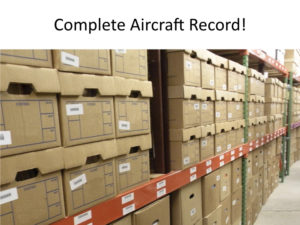 The first time I showed just a logbook, meaning like a nice little binder of documents. And then the second time I’m showing bankers boxes full of documents stacked in a hangar somewhere, along the wall.
The first time I showed just a logbook, meaning like a nice little binder of documents. And then the second time I’m showing bankers boxes full of documents stacked in a hangar somewhere, along the wall.
So a lot of folks don’t really have that much of an idea of what it is, the internal workings of what you do unless you visually show them.
And that makes them step back and say, “Wow, that is a lot more work than I thought it was going to be. Maybe I should have you review the records instead of having me do it.”
John Williams: Oh yeah. I wouldn’t even consider buying a jet or a larger turbo prop or larger, even a larger piston without going through a broker that knows his stuff.
Paula Williams: Yeah, exactly.
John Williams: I did buy two brand new airplanes by myself, and had no issues, but they were small-
Paula Williams: There was not banker’s boxes of history.
Is ABCI Getting a G700?
John Williams: I would even have a broker if I was going to buy a new Gulfstream G700, because there are a lot of things including negotiations on things you wouldn’t even consider.
Paula Williams: Are we buying a G700 for ABCI?
John Williams: No.
Paula Williams: Oh, okay. I thought you knew something I didn’t.
John Williams: I said if I were to.
Paula Williams: Got it, that’d be a great company airplane, don’t you think?
John Williams: Yeah. If we could afford that, we would just sort of wander around the world.
Paula Williams: Exactly. We probably wouldn’t be doing marketing. Well, no, we would, we love it.
John Williams: We could do it from the back of the airplane.
Paula Williams: Exactly. We love what we do. So we’d probably do it even if we had a G700. Then we could go visit clients much more easily.
John Williams: Well not in long term, but that thing takes a lot of runway. You can’t just go into all these little airports.
Paula Williams: It’s horribly impractical. I’m glad you thought of that. Okay.
People don’t know what they don’t know . . .
So someone who is a consultant like Sherry Chaput at Avion Trace. This is what she deals with every single day. And by showing this to her clients, they get it really quickly, that they really need a Sherlock Holmes that specializes in aircraft records. So if you’re a consultant of any sort, I think people tend to underestimate the difficulty of what it is that you do, unless you can visually show them an example.
John Williams: Absolutely.
Paula Williams: And video is a great way to do that. And you can do it was still photos that you video over or voiceover. You can do that with a Ken Burns effect, there’s lots of things that you can do to make that more dramatic and cool.
Explain what you do to justify the prices you charge.
John Williams: Even if you’re in maintenance and you rebuild turbines, and it happens to be a pricey thing, but then when you see a video of what they actually have to do, and what they inspect and how they take it apart, mike out each piece of a rotor or stater, and put it back together again, you know crap, that takes a lot of time.
Paula Williams: Yeah, exactly. That is absolutely-
John Williams: And specialized tools. I mean it just, the industry is expensive.
Paula Williams: It is.
John Williams: People forget that when they want to buy a service or a product.
Paula Williams: Right. And so when you are explaining the value of what you do, or explaining your price especially, or before you explain your price, you want to make sure that people understand what they’re getting, because they probably have a different idea than you do about what an aircraft log book looks like. Here’s another idea of ways that you can visually explain what you do, or a thing that you can do with video.
Newsjacking – Using current events to illustrate your area of expertise.
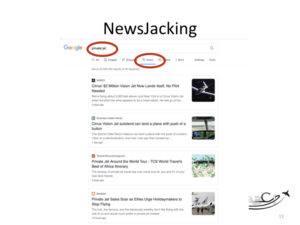 And that is a thing called newsjacking. You can get a lot of really great ideas for the newscaster talking head kind of video, things to talk about on video, just looking at the news.
And that is a thing called newsjacking. You can get a lot of really great ideas for the newscaster talking head kind of video, things to talk about on video, just looking at the news.
This is just today, I looked up private jet on Google, and I used the category of news, and there are a bunch of things that an aviation consultant could talk about that happened just today. Well, actually within the last week.
So Wired magazine talked about Cirrus’s two million dollar Vision jet now lends itself, with no pilot needed.
John Williams: Thank you very much Garmin.
Paula Williams: Thank you very much Garmin, exactly. And Cirrus is doing a much better job than Garmin I think of promoting this.
John Williams: Well they make it sound like-
Paula Williams: Like they did it.
John Williams: Like they did it, when in fact they’ve purchased everything they needed from Garmin, and Garmin has spent the last nine, eight and a half, nine years putting this together.
People talk about the news -join the conversation!
Paula Williams: Right. So if you are an aviation consultant, I am sure that you have an opinion on this and I’m sure that your customers would love to hear what that opinion is, and that helps establish your thought leadership and your positioning of you as an expert on some of these items that you talk about.
And then there’s another of the same topic from Business Insider, Town and Country magazine talks about a private jet around the world tour, best of Africa itinerary. If you are an aviation consultant that does anything having to do with private travel, recreation, charter, anything like that, you might talk about international considerations.
You might talk about if you’re flying in Africa, here’s some things you need to know about customs. There’s a lot that this could jump off into.
Paula Williams: And then the last one, private jets soar as elites stop. Oh, urge holiday makers to stop flying. So that is an interesting thing that’s going on. A lot of people are not wanting to be visibly flying first class anymore. They want to have a private jet that’s unlisted and has a tail number that’s unregistered well, where the tail numbers cloaked. So there’s a lot more privacy with private travel, especially these days when there is some backlash about that sort of thing.
John Williams: And just being secure based on world events.
Cautionary Tales
Paula Williams: Right. So, if you are in aviation consultants having to do with security, high net worth, ultra high net worth individuals, celebrities, anything along those lines, that would be a great jumping off point to talk about that article and the implications. So good ideas.
Another one is cautionary tales. So we had a broker who had clients that were kind of dead set on the Cirrus, because it has a parachute. And it was not a great aircraft for the mission that they had in mind, and he was trying to talk them out of it. And he had kind of a number of these same types of clients that felt like this parachute is the end all and be all of safety.
Choose stories carefully and use discretion!
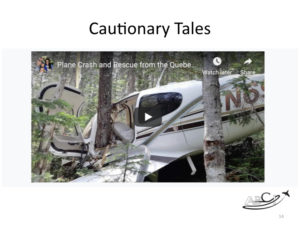 And this is actually a plane crash and wreck rescue of a doctor in Quebec who deployed his parachute, and came down in a forest full of trees. And it comes down pretty hard. In this case, it came down on some sharp trees, and they went right through the airplane. He was fine.
And this is actually a plane crash and wreck rescue of a doctor in Quebec who deployed his parachute, and came down in a forest full of trees. And it comes down pretty hard. In this case, it came down on some sharp trees, and they went right through the airplane. He was fine.
Paula Williams: So you could feel a lot more okay about talking about this then you would if it had been a tragic incident and you’d have to be a lot more cognizant of the families and sensitive to what had happened.
But since he did the video of this and published it so that people would know about it, I think as an aircraft consultant, I would feel a little bit more comfortable with mentioning this video and saying there’s a video on YouTube. This doctor filmed his whole rescue and everything else and wanted people to know that this is what happened. And it tore his shorts. That’s the worst thing that happened to him, and scraped his leg.
John Williams: But the tree came through the cockpit. I mean, he was very lucky.
Paula Williams: Oh yeah, absolutely. So you know, that parachute is a wonderful thing, but it is not necessarily a cure all for anything that could possibly go wrong in a safety in every situation. So, in some cases at different aircraft may be better for your clients and this might be what you need in order to convince them of that.
John Williams: Could be.
Question and Answer Format
 Paula Williams: Right. Okay, cool. Another type of thing that you can do, especially with the newscaster talking heads, or with Ken Burnsing a photograph or with stock footage or anything else is a question and answer, like a question of the week, is a great way to do a series of videos that establish your thought leadership and help you, and if you’re getting questions from clients, of course you’ve got material.
Paula Williams: Right. Okay, cool. Another type of thing that you can do, especially with the newscaster talking heads, or with Ken Burnsing a photograph or with stock footage or anything else is a question and answer, like a question of the week, is a great way to do a series of videos that establish your thought leadership and help you, and if you’re getting questions from clients, of course you’ve got material.
If you’re not getting questions from clients, a lot of times they don’t know what to ask.
Use actual questions, or questions your clients SHOULD be asking!
So what should they be asking you? And that can be your question of the week.
Word of the Week
 Word did the week. So this is probably the easiest one for a micro video. And what I mean by micro video is like one minute or less. And the thing I like about micro videos is that they can be used on Facebook, Twitter, LinkedIn, Instagram as is.
Word did the week. So this is probably the easiest one for a micro video. And what I mean by micro video is like one minute or less. And the thing I like about micro videos is that they can be used on Facebook, Twitter, LinkedIn, Instagram as is.
Paula Williams: So you get a lot of mileage out of one video file that you produce. So if you did these once a week, and some of our clients are doing that, doing a term of the week or something along those lines, and I’m not talking kindergarten words, right, so don’t think that this is a kindergarten thing.
Depending on your specialty, or whatever, I am sure that there are things that your clients don’t understand as they should, or maybe think that they understand but don’t really.
John Williams: Exactly.
Paula Williams: And are confused about-
John Williams: Here she’s got some examples on the slide.
Paula Williams: Exactly. And you would never, they would never stoop to ask you what does due diligence mean? If anything, they’re going to go to Google and look it up. And it’s not necessarily the definition you want them to have.
John Williams: Exactly.
Paula Williams: Because they’re going to find a generic definition when it maybe means something very specific in your line of work, like due diligence, fiduciary responsibility, fractional ownership indemnity.
Specialized definitions are interesting little “information snacks,” position as an expert, and make a lot of opportunities for SEO keywords you want to be associated with!
If you are a consultant in the aviation industry, these things mean something different probably to you than they would to your typical insurance agent, or even other technical specialist in some other field.
Okay.
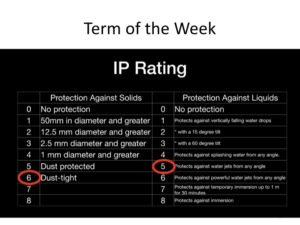 So a word of the week is a great way to educate your customers, especially while they’re considering purchasing from you. Okay. Here’s an example of one.
So a word of the week is a great way to educate your customers, especially while they’re considering purchasing from you. Okay. Here’s an example of one.
This is from Tech Center Guam talking about UAVs. Every UAV has an IP rating, and it’s just a two digit number, so when you go to buy a drone, it has an IP rating on it. This is a really easy way to remember it.
The first digit is its protection against solids. The second digit is its protection against liquids. So a drone with an IP rating of six five as an example is safe from dust, so you can use it in a desert environment or whatever. And it is also safe from water jets from any angle. So not necessarily-
John Williams: So what does IP mean?
Paula Williams: Immersion or anything that is…
John Williams: Do you know? Do we know?
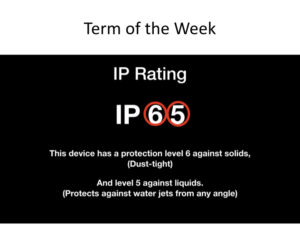 Paula Williams: Yeah, we do. I did know until you asked me. I don’t see it now. What’s an IP rating? Of course… Okay. It is a international protection rating.
Paula Williams: Yeah, we do. I did know until you asked me. I don’t see it now. What’s an IP rating? Of course… Okay. It is a international protection rating.
John Williams: Yeah. Interesting.
Paula Williams: All right.
John Williams: Well that was new for me.
Paula Williams: Right. Okay. So it’s an international protection rating, and if you go to Tech Center Guam’s website, they go through the whole definition, telling you what the acronym is, what it stands for, how it works and all those things.
So an IP rating of six five has a protection level six against solids, and a protection level five against liquids. So you can’t immerse it in water, but you can shoot water pistols at it, right?
John Williams: Yeah.
Paula Williams: Okay, cool.
John Williams: Once they get underwater submersible stuff, then that’ll be interesting how they do that.
Paula Williams: Yeah, exactly. And there’s an IP rating for those too, which is really cool, but it’s higher than that. So that’s something that you would need to know if you were a UAV consultant or if you were buying a UAV or something along those lines, or if you’re taking the course, one of their UAV courses. But as an average human being running around in the world, I wouldn’t know or need to know that.
So it’s a great way to attract the right audience, that’s interested in this is clearly more likely to be a customer of yours than the-
John Williams: The average Joe buying one of these might actually want to know if he’s in a sandy environment, or a damp environment, even if he’s just a hobbyist.
Paula Williams: That’s true. But even if they’re just a hobbyist, they’re more likely to be a customer of Tech Center Guam than the average guy running around.
John Williams: I’m just saying they weren’t, I’m just saying would be interested.
Paula Williams: That’s true. Okay. So term of the week, or word of the week is a really, really easy way of doing these micro videos. Another one is a team member profile.
Team member highlights or profiles
 Everybody has really interesting people working with them, and they’re often a lot more interesting than anybody ever knows. And if you can put the story behind the face, that really makes people feel a lot more connected, and feel like they’re part of your company or feel more likely to remember your company because they remember, oh yeah, that’s where that cool guy works. And this is Doug Rumminger, there are many Dougs at Special Services Corporation.
Everybody has really interesting people working with them, and they’re often a lot more interesting than anybody ever knows. And if you can put the story behind the face, that really makes people feel a lot more connected, and feel like they’re part of your company or feel more likely to remember your company because they remember, oh yeah, that’s where that cool guy works. And this is Doug Rumminger, there are many Dougs at Special Services Corporation.
This is one of them. He’s the one that you’re most likely to be talking to when you pick up the phone and call SSC, you’ll talk to one of several Dougs. This one’s the most likely.
Paula Williams: And he has this hobby that is fascinating. And I had no idea till we’d been talking for probably half an hour, that he does this.
And I didn’t do a video. I did an article about this because this was a couple of years ago and this just happened to be a chance conversation. But if I were to do this over again, I would do a video, and we might still do a video of this, but he does 1/525th scale aircraft models, and these things are so incredibly detailed, and they’re historical, and they’re cool and they’re made out of anything.
Little bits of balsa wood or paper or paint, glue, polymers, whatever he has to work with. But these are fascinating. They’re unbelievable.
Paula Williams: Right. So these are so tiny, you can see what they look like compared to a key or a pen. He put those in there for scale, and he makes these little scenes with clouds and stuff. It’s absolutely fascinating. Some people do like railroad sets that are to scale. And I have never seen aircraft models this tiny and this detailed.
John Williams: Yeah, me neither.
Paula Williams: So anyway, if you ever talk to Doug Rumminger at SSC, ask him about his models. Those are really, really cool. But there are people that work with you undoubtedly that have something like this that is so incredibly cool, that you would never know unless you spent some time talking with them. And if you can make a little video out of that, then people who do business with you will know more about your folks. They feel better about working with people they know, it’s all about relationships these days.
So that is a wonderful thing.
Happy customers stories
And speaking of relationships, this is the, we’re going to close with the most powerful form of video, and this is a happy customer story. And a lot of people will say, I’m an aviation consultant, privacy is a real big deal to my customers. Nobody’s going to go on video. Not necessarily true.
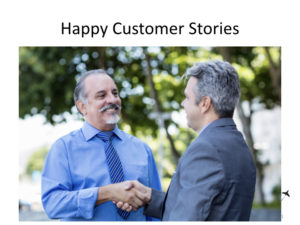 John Williams: No, it isn’t. The fact is if they’re happy, they’re more than likely very willing if they have an opportunity to do a video for you.
John Williams: No, it isn’t. The fact is if they’re happy, they’re more than likely very willing if they have an opportunity to do a video for you.
Paula Williams: Exactly. You’d be amazed at what people will do for and with you if you ask, and we’ve had clients do this for us, and it’s been one of our very best sales tools, and often aviation consumers have a reason that they also want the publicity. So people who are in real estate, people who are in car sales, people who are doctors who use private aviation to get to their customers. They want people to know that they’re successful and that they have an airplane, so they have a motive to also want the publicity and being on video for them is free.
John Williams: Works to a double-edged sword.
Paula Williams: Yeah, exactly. It’s free publicity for them as well as for you. So it doesn’t hurt to ask, if they tell you no, okay, that’s great. They might give you a written testimonial, maybe just with their initials or maybe with their company name left off, but never hesitate to ask for a testimonial.
A video testimonial is the gold standard, because they can’t yet be faked without some very good equipment, and very skillful people.
John Williams: And a lot of time.
Paula Williams: And a lot of time. So yeah, a happy customer story on video is the very best advertising we can do for anybody.
Want us to create a video marketing plan for you?
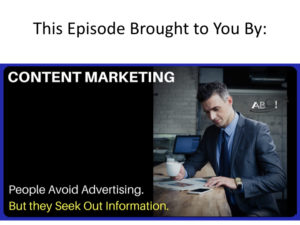 So that’s the first thing we ask about when we do a video plan is do you have any happy customers we can interview? If so, great.
So that’s the first thing we ask about when we do a video plan is do you have any happy customers we can interview? If so, great.
If not, we’ll look at the rest of these ideas and come up with a plan over the course of at least six months.
That’s the minimum contract length for our content marketing program. If you’re doing this on your own, you probably want to think in those terms as well. You want to think in terms of a set of videos that you can do over a course of time, because we do have a long sales cycle in the aviation industry.
So you don’t want to do just a one and never do video again.
Anything you do you want to do multiple times, because you’ve got a long time to build that relationship before they pull the trigger and spend money on you. So thank you for joining us, and we’ll see you next week.
John Williams: Have a great day.
–
Podcast: Play in new window | Download
Subscribe: Spotify | Amazon Music | RSS

